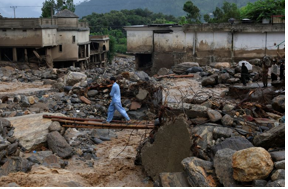INP-WealthPk
Ayesha Saba
Pakistan’s critical infrastructure has sustained damage exceeding Rs307 billion as torrential floods between June and September 2025 tore through roads, bridges, power grids and transport networks, severely disrupting the country’s logistical backbone and economic connectivity, according to a preliminary assessment released by the Ministry of Planning, Development and Special Initiatives.

The official document reveals that more than 2,811 kilometres of roads and 790 bridges have been destroyed or rendered unusable nationwide. Punjab, Khyber Pakhtunkhwa, Gilgit-Baltistan and Azad Jammu & Kashmir reported the heaviest structural losses, while hilly regions faced near-total destruction of connecting bridges due to flash floods and cloudbursts.
The ministry warned that the resulting breakdown of transport and storage facilities has shaved off nearly two percentage points from the sector’s growth outlook for FY 2026. “The transport and storage sector is now projected to grow only 1.5 percent—less than half its target of 3.4 percent,” the report stated. “This slowdown will have cascading effects on agriculture, industry and commerce, all of which depend on efficient logistics.”
Beyond roads, the power infrastructure also sustained extensive damage—collapsed transmission lines, uprooted poles, broken transformers and disrupted grids—causing widespread blackouts in flood-affected regions. Preliminary estimates place financial losses in the energy sector at around Rs25 billion, with the electricity, gas and water supply subsector expected to grow only 2.8 percent instead of 3.5 percent this year.
The report highlighted that the collapse of bridges in mountainous districts such as Battagram, AJK and GB demonstrates the vulnerability of high-altitude infrastructure to flash floods. It urged authorities to “prioritise climate-resilient engineering, improved hydrological mapping and the use of flood-resistant materials.”
According to provincial submissions appended to the report, the National Highway Authority alone recorded losses of over Rs14.4 billion on federal road networks, while provincial road departments reported combined damage exceeding Rs137 billion. The Pakistan Railways reported Rs3.79 billion in losses, including 16.2 km of damaged track and more than Rs2.6 billion in ticket refunds and freight revenue shortfalls due to suspended services.
Economic analysts cited in the report fear that the prolonged disruption of supply chains will push up transportation costs, delay industrial shipments and inflate consumer prices, aggravating inflationary pressures already fuelled by crop losses. The ministry warned that unless urgent rehabilitation begins, logistical paralysis could hinder national recovery and export competitiveness.
Rehabilitation experts estimated that full reconstruction of damaged infrastructure could take five to ten years, depending on financing and access to remote areas. The government plans to channel funds from the Public Sector Development Programme towards road restoration and bridge rebuilding, while prioritising “build-back-better” standards to withstand future disasters.
“The 2025 floods exposed serious infrastructure gaps and outdated drainage planning,” the report concluded. “Pakistan’s next phase of development must integrate disaster-resilient design, early-warning systems and climate-informed budgeting across all infrastructure sectors.”
Credit: INP-WealthPk













